|
|
|
||
|
Our History
A Union is Born
The Turbulent Years
The Conspiracy Trials
The Beginning of the
Morrin Era
The Depression and a New
Deal For Labor
World War II
Ironworkers Grow in the
1950's Part Two Part Three
John H. Lyons Jr.
Elected President
The Tradition Continues
Pathways to the 21st
Century Under The Leadership of General President Jake West
|
Part Five
President Morrin reported that our membership was up to a new high of 41,259. This was the result of the organizing campaign that was authorized at the last Convention. He stated that "the passage of the Social Security Act is a great benefit to our members. When they have 40 quarters of coverage they will be 'fully insured' and able to retire with monthly benefits at 65 years of age."
JOBS DURING THE DEPRESSION
Along with the Brooklyn Bridge, the Golden Gate Bridge is one of the world's best known bridges, and a civil engineering masterpiece. Construction was officially begun January 5, 1933 and the ground breaking ceremony was held on February 26, 1933. The opening of the bridge to traffic was on May 28, 1937, however, the day before was designated "Pedestrian Day" when thousands of people enjoyed exclusive use of the new bridge. Joseph B. Strauss was the chief engineer. The 4,260 foot center span superseded the span of the George Washington Bridge. More than 100,000 tons of steel, 693,000 cubic yards of concrete, and 80,000 miles of wire cable were used in the bridge's construction.
The San Francisco-Oakland Bay Bridge was started in 1933 and completed in November, 1936. Ironworkers from Local No. 377 and Local 378 worked on this Bridge. The construction of the bridge required enough timber to build houses for a town of 15,000 people, and enough concrete and reinforcing steel to rebuild downtown San Francisco. The concrete and steel in the bridge would build thirty-five skyscrapers. This bridge contains fabricated steel equal in tonnage to eighteen percent of all the steel fabricated in the United States in 1933.
Created during the first Hundred Days session of Franklin D. Roosevelt's presidency in 1933, the Tennessee Valley Authority TVA brought power to rural areas along the Tennessee River in seven states. Progressive reformers long had argued for government ownership of municipal services, and the Great Depression and the resulting financial problems of private utilities gave them the chance to enact one such project. Roosevelt sought a coordinated plan involving industrialization, soil conservation, reforesting, and the provision of electricity in the seven-state area. The measure set up the TVA board to construct dams and power plants in Tennessee, Alabama, Mississippi, Kentucky, Virginia, North Carolina, and Georgia. The agency eventually built five dams, improved twenty others, and constructed a system of inland waterways. The TVA also became involved in local communities, selling fertilizers and electricity, building flood control projects, improving the navigation of the meandering river, and engaging in programs of reforestation and soil conservation.
NATIONAL DEFENSE National Defense was one of the main subjects covered at the 26th Convention. President Morrin said "today, practically all of Europe is engaged in a war which has already destroyed the liberties of most European countries with their democracies either wiped out or threatened with destruction and their rights trampled underfoot. We in America who have enjoyed the rights and liberties granted to us by our constitution can scarcely realize the extent to which the invasion of countries may reach. Today and for the past few months our country has been carrying on a stupendous war defense program. This is a colossal task because of the vast shore and boundary lines of the United States and its possessions which must be defended in the event of invasion. These are not dreams or idle thoughts; they are not possibilities but realities, if we are to be guided by the total disregard of the European democracies by the worlds most heinous war monster Adolph Hitler."
Hitler had come to power in Germany at the same time that Roosevelt was elected President. Both Germany and the United States were in the grips of the depression, but the way we solved our problems compared to Hitler's Germany were like night and day. Hitler had solved his economic problem by building up the military; we had "The New Deal" to help build up the nation and give jobs to workers. Italy also had economic problems and, in 1935, Mussolini picked a quarrel with Ethiopia and invaded that African nation. Japan had also developed a military machine, and in 1931 invaded Manchuria and went to war with China in 1933. Then in 1936, Germany and Italy took the side of the dictator, Franco, in Spain and civil war broke out. In that same year Hitler invaded the demilitarized Rhineland in violation of the treaty that ended World War I. A speech Roosevelt gave on October 5, 1937, is known as the "Quarantine Speech." Roosevelt was particularly concerned with the aggressive policies of Germany in Europe and Japan in the Far East. Roosevelt said:
Roosevelt went on to say we wanted peace but we had to be prepared. An increase in military spending was passed by Congress. Many of our members were able to get jobs as riggers in various navy yards on both coasts. By March of 1938, Hitler had annexed Austria. In September of that year he took over Czechoslovakia. On September 1, 1939 Germany invaded Poland and on September 3rd England and France declared war on Germany. The Second World War had begun. Although the United States declared neutrality on September 5, 1939 by June 27 of 1940, the United States declared a national emergency. On September 16, 1940 the selective training and service act was approved, and a month later men between the ages of 21 and 35 were required to register for selective service. The nation and the labor movement still divided in 1940 over what role we should play in this world-wide conflict, but the attack by Japan on Pearl Harbor on December 7, 1941 would unify the nation.
Scroll to the top and click on
World War II and the Post War
Struggles
[Home]
[Officers]
[Upcoming
Events] |
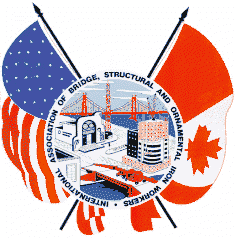
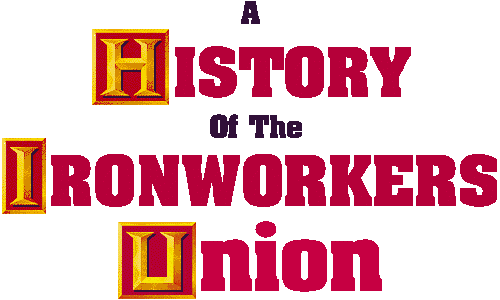
 he
Twenty-Sixth International Convention was held September 16th to the 21st,
1940 at the hotel Jefferson in St. Louis Missouri. P. J.
Morrin was reelected General President, John H. Lyons was elected General
Secretary and John J. Dempsey was elected General Treasurer.
he
Twenty-Sixth International Convention was held September 16th to the 21st,
1940 at the hotel Jefferson in St. Louis Missouri. P. J.
Morrin was reelected General President, John H. Lyons was elected General
Secretary and John J. Dempsey was elected General Treasurer. In
spite of the poor economic conditions during the 1930's, several large,
landmark jobs were constructed during the depression. among these were the
Empire State Building in New York City, the Golden Gate bridge in San
Francisco, Hoover Dam in Nevada, the Tennessee Valley Authority in
Tennessee and the San Francisco - Oakland Bay Bridge.
In
spite of the poor economic conditions during the 1930's, several large,
landmark jobs were constructed during the depression. among these were the
Empire State Building in New York City, the Golden Gate bridge in San
Francisco, Hoover Dam in Nevada, the Tennessee Valley Authority in
Tennessee and the San Francisco - Oakland Bay Bridge.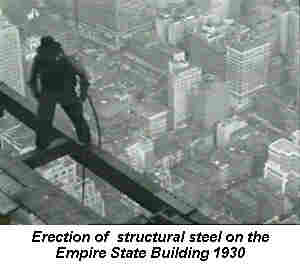 Construction
began on the Empire State Building on March 17, 1930. The building
rose at the rate of 4 1/2 stories per week (a record which still
stands). One year and forty-five days later in May, 1931
construction was complete on what was then the tallest building in the
world.
Construction
began on the Empire State Building on March 17, 1930. The building
rose at the rate of 4 1/2 stories per week (a record which still
stands). One year and forty-five days later in May, 1931
construction was complete on what was then the tallest building in the
world.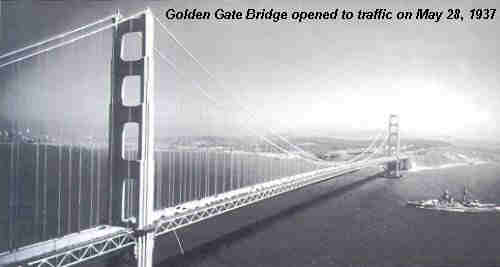
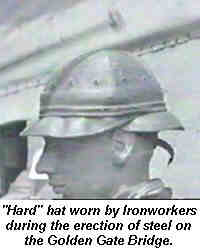 Several
new safety measures were used in the construction of this bridge.
Every man was required to wear a "hard" hat to minimize head
injuries from falling objects. The hard hats were primitive - made
out of leather, similar to a football helmet. Because of the
confined space within cells, extra precautions were taken against lead
poisoning. This ailment was suspected in several workmen and as soon
as its likelihood was discovered, all men were examined physically every
two weeks and blood counts taken. All riveters were required to wear
respirators, and provisions made so hands could be kept clean to prevent
hand to mouth infection. As a result of this experience on the Marin
Tower, the paint on the splices of the San Francisco Tower, then in the
process of fabrication was changed from red lead to iron oxide. A
great
Several
new safety measures were used in the construction of this bridge.
Every man was required to wear a "hard" hat to minimize head
injuries from falling objects. The hard hats were primitive - made
out of leather, similar to a football helmet. Because of the
confined space within cells, extra precautions were taken against lead
poisoning. This ailment was suspected in several workmen and as soon
as its likelihood was discovered, all men were examined physically every
two weeks and blood counts taken. All riveters were required to wear
respirators, and provisions made so hands could be kept clean to prevent
hand to mouth infection. As a result of this experience on the Marin
Tower, the paint on the splices of the San Francisco Tower, then in the
process of fabrication was changed from red lead to iron oxide. A
great 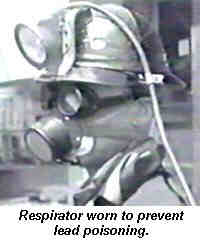 aid
to the speed of erection was the the use of a safety net. This net
made of manila rope, 3/8 inches in diameter and six inch square mesh, was
placed progressively under the suspended structure as the latter was
erected so that eventually it extended under the bridge its entire length
between pylons and was wide enough to extend ten feet outside the trusses
on both sides. In addition to saving nineteen lives during the
construction, there is no question
aid
to the speed of erection was the the use of a safety net. This net
made of manila rope, 3/8 inches in diameter and six inch square mesh, was
placed progressively under the suspended structure as the latter was
erected so that eventually it extended under the bridge its entire length
between pylons and was wide enough to extend ten feet outside the trusses
on both sides. In addition to saving nineteen lives during the
construction, there is no question 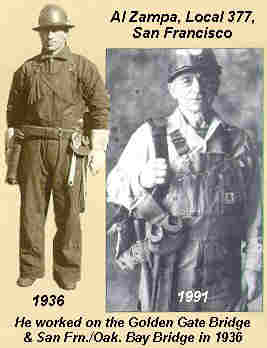 but
what the men worked faster and more efficiently since they felt the
protection of the net below them and were able to move about more
freely. One of the Ironworkers that fell and was saved by the net
was General Vice President Dick Zampa's father, Al Zampa.
but
what the men worked faster and more efficiently since they felt the
protection of the net below them and were able to move about more
freely. One of the Ironworkers that fell and was saved by the net
was General Vice President Dick Zampa's father, Al Zampa. The
Hoover Dam was built on the Colorado River in Nevada. The bids for
this job were awarded in 1931. The river was diverted around the dam
site in November, 1932 and the first concrete was poured on June 6,
1933. The last concrete was poured in the dam on May 9, 1935.
President F. D. Roosevelt dedicated the dam on September 30, 1935.
The first generator went into full operation on October 26, 1936.
The
Hoover Dam was built on the Colorado River in Nevada. The bids for
this job were awarded in 1931. The river was diverted around the dam
site in November, 1932 and the first concrete was poured on June 6,
1933. The last concrete was poured in the dam on May 9, 1935.
President F. D. Roosevelt dedicated the dam on September 30, 1935.
The first generator went into full operation on October 26, 1936.